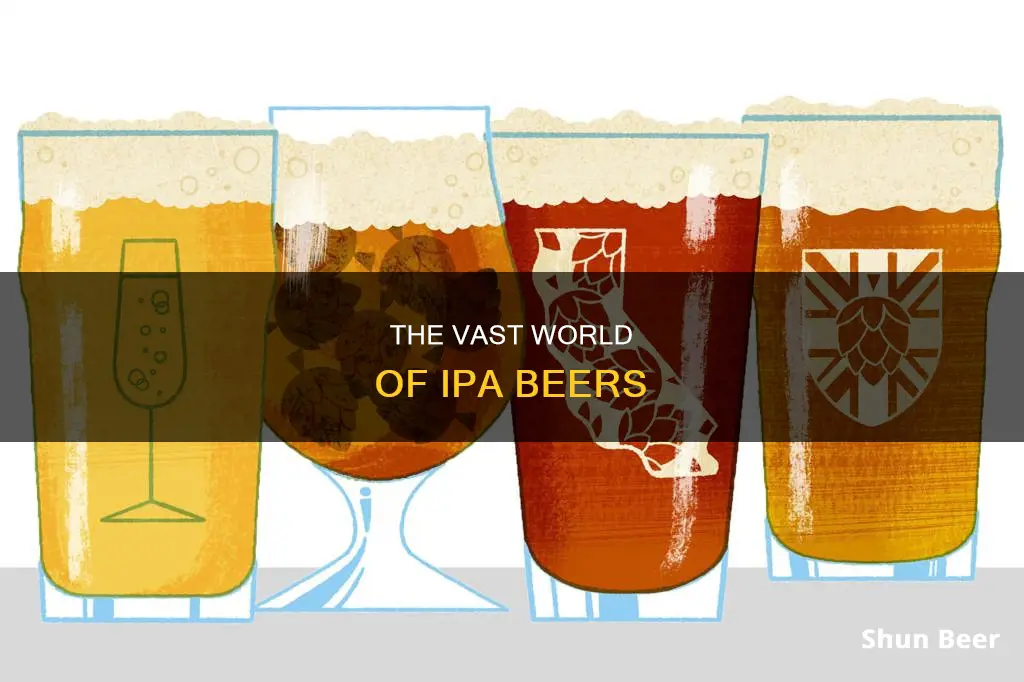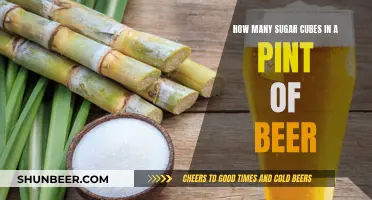
India Pale Ale, or IPA, is a hoppy beer style within the broader category of pale ale. IPAs are known for their high hops content, which gives them a signature bitterness. While they are generally bitter, IPAs can also have nuances that range from citrusy to herbaceous and even evergreen. The Beer Judge Certification Program (BJCP) currently identifies nine distinct types of India Pale Ale, but there are many more variations on the market.
What You'll Learn

History of IPAs
India Pale Ale (IPA) is a hoppy beer style within the broader category of pale ale. The story of its origin is often simplified to a legend: in the late 18th century, George Hodgson, a brewer at the Bow Brewery in East London, started sending his pale ale to India with extra hops and increased alcohol content. The hops and alcohol helped preserve the beer during its long journey from England to India, creating a bitter and stronger pale ale that was more refreshing in the hot Indian climate.
However, the true story is a bit more complex. English breweries in the 18th century were looking for ways to prevent their beer from spoiling during the voyage from England to British colonies in India and the Caribbean. Beer stored in large casks, called hogsheads, would spoil and go flat due to warmer temperatures and the jostling of the ship. By the 1760s, breweries discovered that adding extra hops to their beers helped fortify them for the voyage to warmer climates. They were adding hops not only to pale ales but also to porters and ales, and the exported beer wasn't much stronger in alcohol content.
George Hodgson was not the first brewer to come up with the idea of adding extra hops, but he was the first to achieve widespread distribution in India. The Bow Brewery was popular with East India Company traders due to its proximity to the company's docks and the fact that Hodgson offered a generous 18-month credit line.
The East India Company eventually became frustrated with Hodgson's business practices and sought new brewing partners in Burton upon Trent, where brewers had recently lost their valuable export markets in Russia. The Allsopp, Bass, and Salt breweries improved upon Hodgson's recipe for hopped pale ale and took over the Indian market.
By the early 19th century, "pale ale prepared for the India market" was gaining popularity, with exports and hopping levels increasing. The first known recorded mention of the phrase "India Pale Ale" was in 1835 in the Liverpool Mercury. By the 1830s, beer drinkers in England were able to taste this export-style pale ale, and by 1840, India Pale Ale became one of England's best-selling beers.
The popularity of India Pale Ales in England declined by the start of the 20th century due to new styles entering the market and increased taxes on higher-gravity beers. However, the story of IPA didn't end there. In the 1970s and 1980s, during the early craft beer revolution in America, brewers revived the original recipes created 150 years earlier in England while adding new styles of hops. This led to the creation of American IPAs and, eventually, the various styles of IPA available today.
Beers Across America: A Diverse and Delicious Journey
You may want to see also

IPA vs. regular beer
India Pale Ale, or IPA, is a subcategory of pale ales. While the two types of beer share similarities, there are several key differences between them.
First, let's look at the history of each. Pale ales were developed in the 1700s when British brewers began roasting lighter malts, resulting in a paler amber shade. In the 1800s, British brewers created IPAs, which were shipped to the Indian colonies. The journey to India was long, so brewers added more hops as a preservative, increasing the alcohol content and flavour intensity. This process also extended the beer's life, ensuring it remained fresh for the four-to-six-month voyage.
In terms of flavour, both pale ales and IPAs have a stronger concentration of hops than other beers. However, IPAs tend to have a harsher hops flavour, often balanced by strong notes of citrus, earthy, or floral tones. Pale ales, on the other hand, have a more balanced ratio of malt to hops, resulting in a sweeter finish. They also have a more robust body and a medium intensity compared to the drier mouthfeel and stronger aftertaste of IPAs.
When it comes to food pairings, ales go well with burgers, Asian food, and pizza due to their complex and fruity flavours. IPAs, often described as bitter, complement spicy, salty, and grilled dishes.
While IPAs and regular beers have their distinct characteristics, the enjoyability of each depends on individual taste preferences. Some may prefer the lighter, hoppy bitterness of a pale ale, while others may favour the bolder, fruitier flavours of an IPA. Ultimately, both types of beer have their merits and can be equally refreshing.
Exploring Diverse Beer Markets: A Global Perspective
You may want to see also

Why IPAs are strong
India Pale Ale (IPA) is a hoppy beer style within the broader category of pale ale. Early IPAs were only slightly higher in alcohol content than other beers brewed at the time. However, more of the wort was fermented, resulting in fewer residual sugars, and they were heavily hopped.
IPAs have a higher alcohol content by volume due to being brewed with higher specific gravities. They are often in the 5-7% ABV range, with some IPAs containing as much as 13% ABV. The higher alcohol content in IPAs is also due to the use of more malt to balance out the increased hop concentration.
The perception of higher alcohol content in IPAs may also be influenced by factors such as the rate at which the body can process alcohol and individual differences in how alcohol is tolerated. Additionally, the body of an IPA tends to be maltier and thicker, which can affect how the alcohol is experienced.
The growth in popularity of IPAs in the 2000s coincided with a greater appreciation for craft ales, which tend to have a higher alcohol content than the lagers and bitters commonly consumed in pubs.
Exploring the Diverse Michelob Ultra Beer Family
You may want to see also

Double IPAs
- Bell’s Brewery Double Two Hearted® Ale: Inspired by Bell’s Brewery's iconic Two Hearted® Ale, this double IPA has two and a half times the amount of Centennial hops and an ABV of 11%. It has strong notes of pine, orange, and grapefruit.
- Cigar City Brewing Company Florida Man: Brewed with a "nearly criminal amount of hops", including Citra, Azacca, El Dorado, and Mandarina Bavaria. This DIPA has big citrus character and peachy, stone fruit notes from a unique Double IPA yeast. It has an ABV of 8.5% and 55 IBUs.
- Dogfish Head 90 Minute Imperial IPA: This revolutionary beer was created by continuously hopping the beer over 90 minutes, resulting in a beyond-bitter beer with robust pine and citrus aromas and flavours. It has an ABV of 9% and 90 IBUs.
- Flying Dog Double Dog: Released to celebrate Flying Dog's tenth anniversary, this DIPA has light caramel malts and pungent citrus flavours from Columbus and Warrior hops. It has a boozy ABV of 12%.
- Half Acre Navaja: A gargantuan DIPA with an ABV of 10% and 100 IBUs. It has sunny, citrusy flavours from Golden Promise malt and Mosaic, Simcoe, Citra, and CTZ hops.
- Lagunitas Maximus Colossal IPA: This colossal IPA from Lagunitas has a massive dry hop of Simcoe and Cascade hops, resulting in a subtly floral-laced beer with an ABV of 9% and 61 IBUs.
- New Belgium Voodoo Ranger Imperial IPA: This IPA is part of New Belgium's flagship Voodoo Ranger series. It uses a party of hops, including Delta, Bravo, Centennial, Cascade, Calypso, and Mosaic, to create an explosion of fresh-cut pine and citrus flavours. It has an ABV of 9% and 70 IBUs.
- Odell Brewing Co. Myrcenary Double IPA: A tropical and bold double IPA with notes of mango, passion fruit, and pineapple from American hops known for high levels of Myrcene. It has a punishing ABV of 9.3% and 80 IBUs.
These are just a few examples of the many excellent double IPAs available on the market. Each one offers a unique blend of hops, malts, and yeast, resulting in a wide range of flavours, aromas, and strengths.
What Makes Beer Gas Tanks Unique?
You may want to see also

Popular IPA styles
IPAs, or India Pale Ales, are extremely popular and come in a wide range of styles. The Beer Judge Certification Program (BJCP) currently identifies nine distinct types of India Pale Ale, but there are many more variations on the market.
One of the most classic styles is the English IPA, which is maltier than its American counterpart, with notes of biscuit and toffee and a lower ABV. These beers are usually golden to amber in colour, with strong floral and earthy aromas.
The American IPA, also known as the West Coast IPA, is hop-forward, with medium to high bitterness. They are typically pale golden to amber-reddish in colour and showcase flavours like orange peel, lemon, grapefruit, pine, and grass.
The New England IPA, or NEIPA, is a juicier, fruitier, and hazier style that originated in New England. These beers still feature hops, but with a focus on late addition and dry-hopping to reduce bitterness. NEIPAs tend to be opaque, pale yellow to golden-orange in colour, and often feature tropical or citrus flavours.
The Milkshake IPA, or Lactose IPA, is a variation of the New England IPA that is brewed with milk sugar (lactose), giving it a creamy, smoothie-like quality. These beers are opaque to golden yellow in colour and often feature flavours like blueberry, passionfruit, tangerine, and guava.
The Sour IPA, or Tart IPA, is another variation of the New England IPA that is kettle-soured or blended with sour beer. These beers have a refreshing acidity and are hoppy, with tropical fruit flavours. They are generally not bitter and can range in colour from opaque golden yellow to deep purple.
The Belgian IPA is brewed with Belgian yeast and European malts, giving it a malty, caramelly, fruity flavour. These beers can range from pale golden to mahogany in colour and typically have notes of citrus and ripe berries, with a pronounced hop bitterness.
The Red IPA, or Imperial Red Ale, is inspired by the Irish Red Ale. These beers are maltier, with notes of toffee and roasted barley, and a welcome bitterness. They can range from amber to burgundy in colour and often feature flavours like orange zest, caramel, and molasses.
The Farmhouse IPA, or Saison, is an ancient style that originated with farmers in Europe. These beers are usually tart, fruity, and funky, with earthy notes like wet hay, grass, or barnyard. They range from clear, sunshine yellow to amber in colour and are often made with tree and vine fruits.
The Black IPA, or American Black Ale, is a darker variation of the typical IPA. These beers have the citrus and piney aromatics of a West Coast IPA, along with stout-like roasted malt character and a touch of sweetness.
The White IPA is a combination of a witbier and a standard IPA. This hazy, pale IPA offers typical Belgian aromas and flavours of bananas, cloves, and coriander, along with a healthy dose of hops.
These are just a few of the many popular IPA styles that can be found on the market today. Each style has its own unique characteristics, showcasing the versatility and creativity of craft brewers.
Beer vs Lager: What's the Difference?
You may want to see also
Frequently asked questions
IPA stands for India Pale Ale.
There are nine major types of IPA recognised by the Beer Judge Certification Program (BJCP) trade body. However, one source lists 10 styles, and another mentions 13% ABV IPAs, which are not included in the nine major types.
The main types of IPA are English IPA, West Coast IPA, East Coast IPA, Double or Imperial IPA, Session IPA, Black IPA, Belgian IPA, New England IPA, and Triple IPA.
IPA is a style of beer that is made with more hops than regular beer, giving it a stronger flavour. However, there is no standardised threshold at which a pale ale becomes an IPA, so it is up to the brewer to decide.
IPAs are not inherently stronger than other beers. Some IPAs have a higher alcohol content than regular beers, but this is not always the case. The perception that IPAs are strong may be due to their increased popularity in the 2000s, which coincided with a greater appreciation for craft ales, which tend to be stronger than lagers and bitters.







